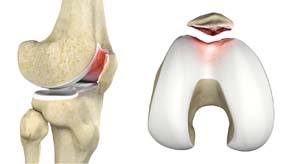
Anatomy of the Knee Joint
The patella, also called the kneecap, is a small bone present on the front of your knee joint. The underside of the patella is covered by cartilage that allows smooth gliding of the knee with movement. Overuse or misalignment of the patella can cause wear and tear of the cartilage.
What is Chondromalacia Patella?
Chondromalacia patella is a common condition characterized by softening, weakening and damage of the cartilage. The condition is most often seen in young athletes and older adults who have arthritis of the knee. It especially occurs in women.
Causes of Chondromalacia Patella
There is no explicit reason why the cartilage gets damaged. It is associated with improper knee alignment or imbalance in the tightness of the muscles holding it in place. Overuse of the knee in certain sports activities may cause wear and tear of the cartilage. This may cause rubbing or grinding of the kneecap against the bone instead of it smoothly gliding over the knee joint.
Chondromalacia patella may also be caused due to injuries such as fractures or dislocations or may develop as a part of your aging process.
Symptoms of Chondromalacia Patella
Chondromalacia patella is the most common cause of knee pain. Called patellofemoral pain, it is characterized by the following:
- Pain in front, around or behind your knee
- Pain that gets worse when climbing up or down the stairs, sitting or standing for long periods, or when extreme pressure is applied on the knee
Other symptoms may include:
- Grinding or cracking sensation or noise when you move your knee
- Rarely, swelling or fluid effusion in your knee joint
Diagnosis of Chondromalacia Patella
Your doctor will conduct a physical examination by applying pressure on different areas of your knee and moving your leg in different positions. You may be asked to undergo imaging tests including an X-ray, CT scan and MRI scan to obtain detailed images of the bones and soft tissues of the knee.
Treatment of Chondromalacia Patella
The treatment of chondromalacia patella initially involves simple conservative procedures. You may be advised to rest your knee and avoid any activity that may strain the knee joint. Your doctor may prescribe painkillers and anti-inflammatory drugs to relieve pain and reduce swelling. Physical therapy may help you to improve the muscle strength, decrease stress on your knee and aid in correcting the misalignment. Wearing support braces and taping around the knee may help you protect your joint, reduce pain and improve alignment. Application of ice on the knee may be recommended after exercise.
When non-surgical treatment does not relieve pain, your doctor may recommend surgical treatment. Surgery may involve:
- Arthroscopy: Your doctor inserts a device called an arthroscope (a thin tube with a camera and light attached) through a small incision. This helps to clearly view the surgical site while other instruments are inserted to remove fragments of the damaged cartilage.
- Realignment: Your surgeon may operate on your knee to realign the position of your kneecap and release pressure over the cartilage.
Your doctor will examine your condition and provide you with the best treatment option.
Related Topics
- Patellar Instability
- Multiligament Instability
- Patellofemoral Instability
- Posterolateral Instability
- Knee Arthritis
- Knee Osteoarthritis
- Knee Injury
- Knee Pain
- Anterior Knee Pain
- Meniscal Tears
- Runners Knee
- Jumpers Knee
- Unstable Knee
- Knee Sprain
- MCL Sprains
- ACL Tears
- MCL Tears
- Meniscal Injuries
- PCL Injuries
- Ligament Injuries
- Knee Fracture
- Fractures of the Tibia
- Patella Fracture
- Tibial Shaft Fracture
- Kneecap Bursitis
- Chondral or Articular Cartilage Defects
- Quadriceps Tendon Rupture
- Patellar Tendon Rupture
- Lateral Meniscus Syndrome
- Osteonecrosis of the Knee
- Knee Angular Deformities
- Osteochondral Defect of the Knee
- Articular Cartilage Injury
- Goosefoot Bursitis of the Knee
- Iliotibial Band Syndrome
- Bowed Legs
- Recurrent Patella Dislocation
- Osteochondritis Dissecans of the Knee
- Chondromalacia Patella
- Patellar Tendinitis
- Knee Sports Injuries
- Multiligament Knee Injuries
- Women and ACL Injuries
- Medial Meniscus Syndrome
- Tibial Plateau Fracture
- Tibial Eminence Fractures
- Loose Bodies in the Knee
- Osgood Schlatter Disease
- Patellar Dislocation/Patellofemoral Dislocation








